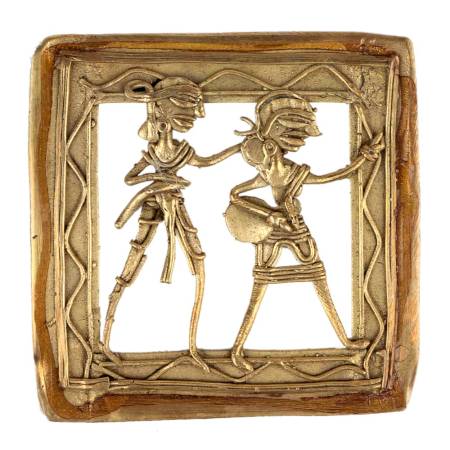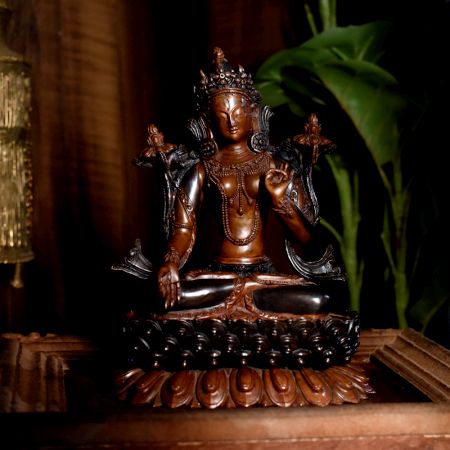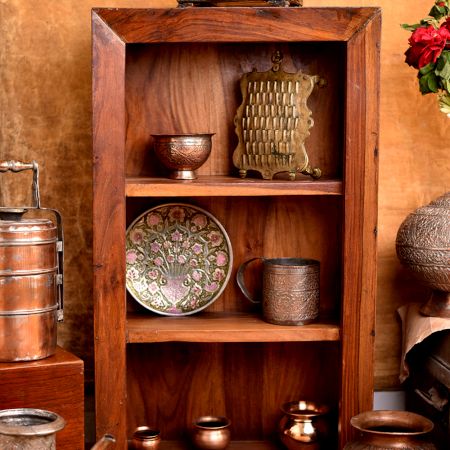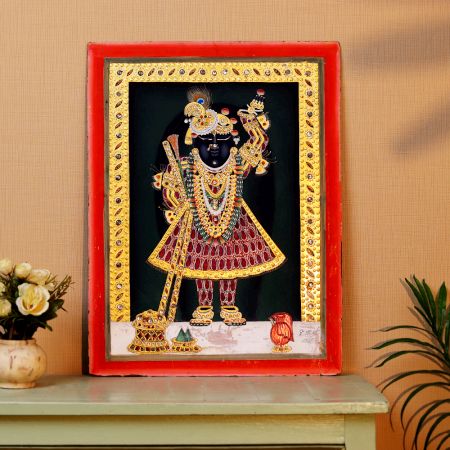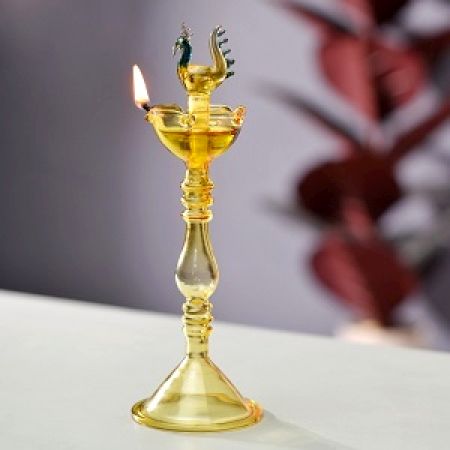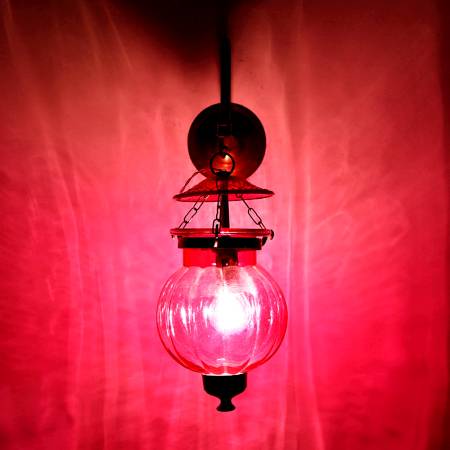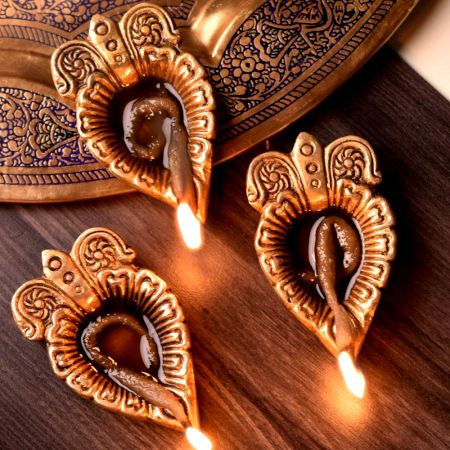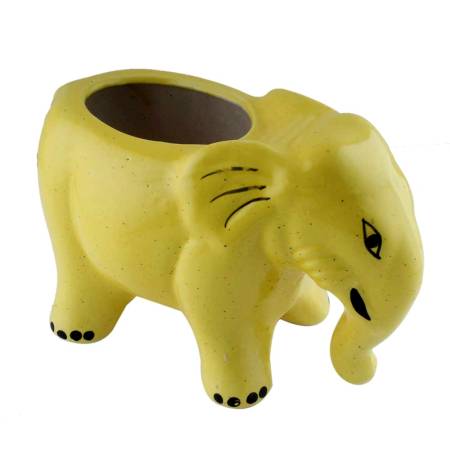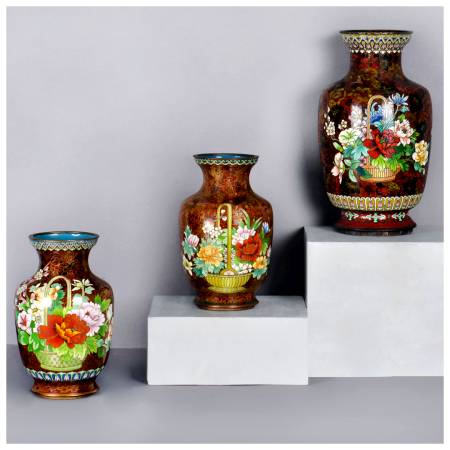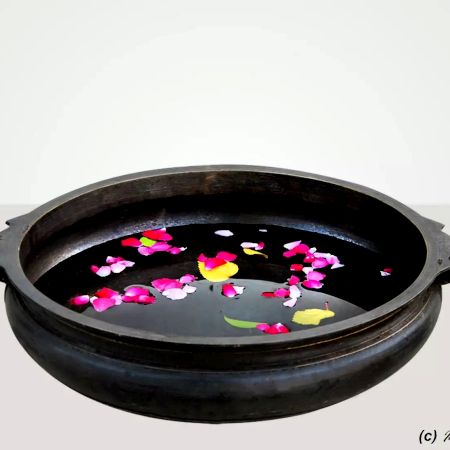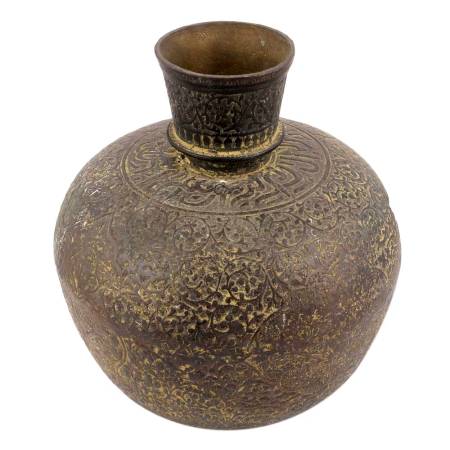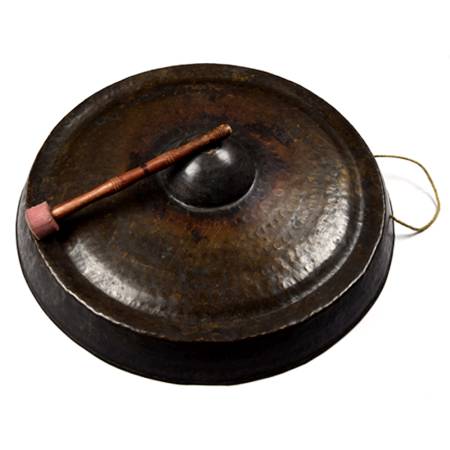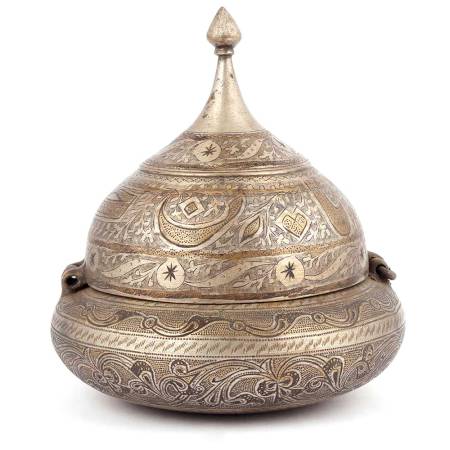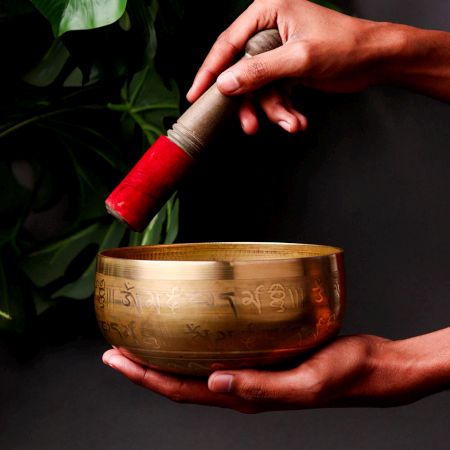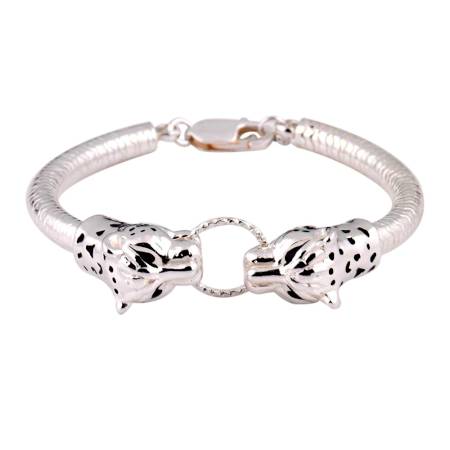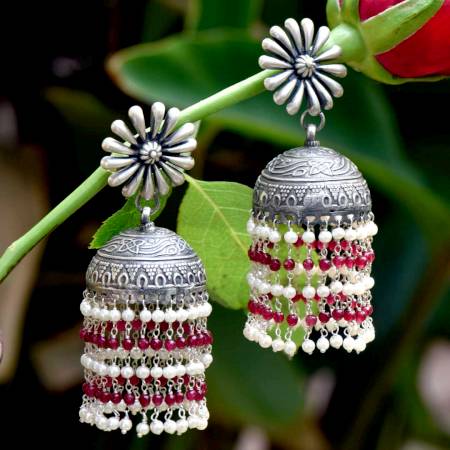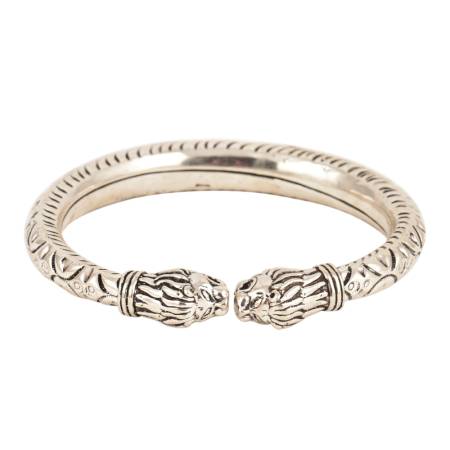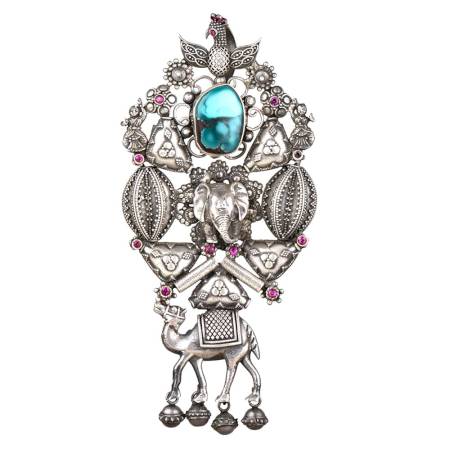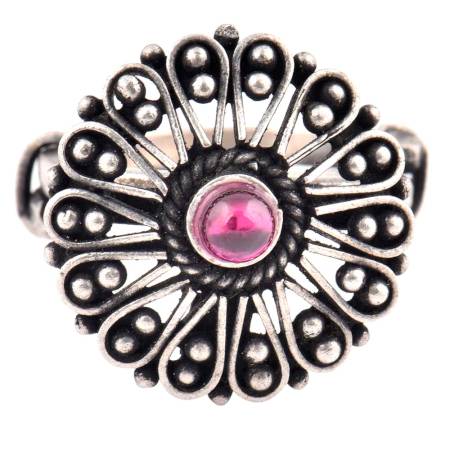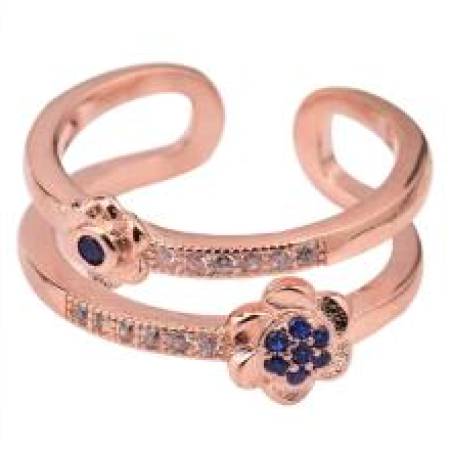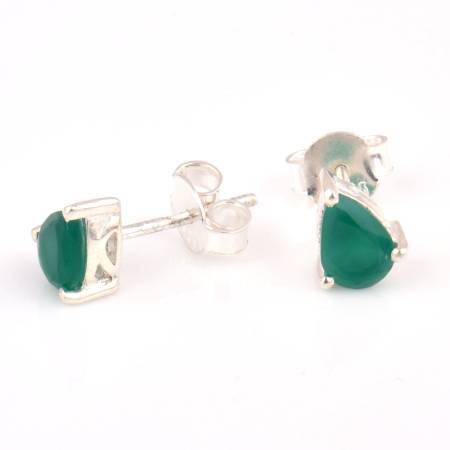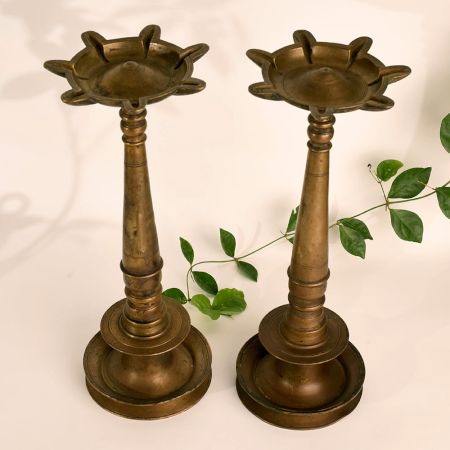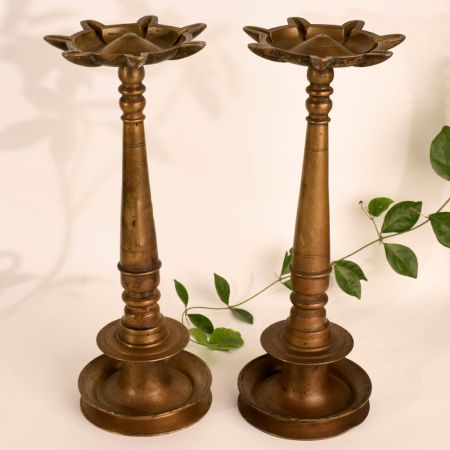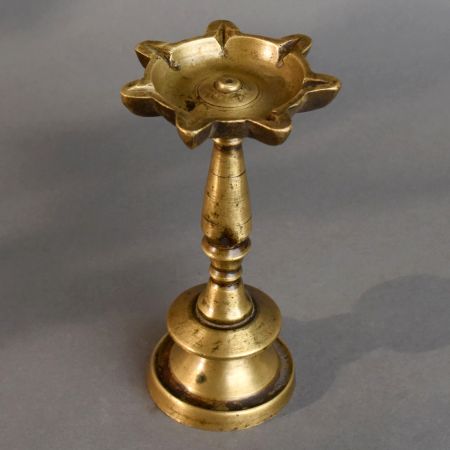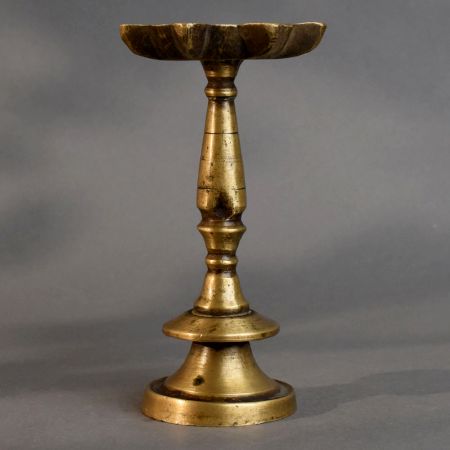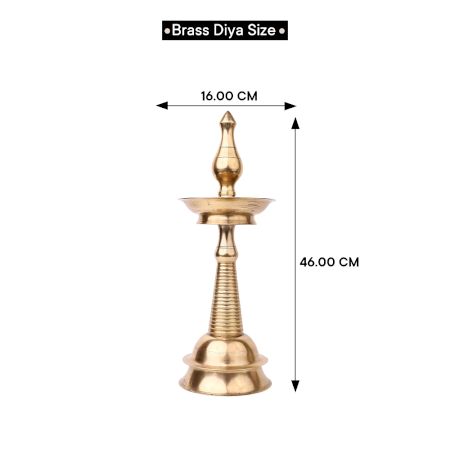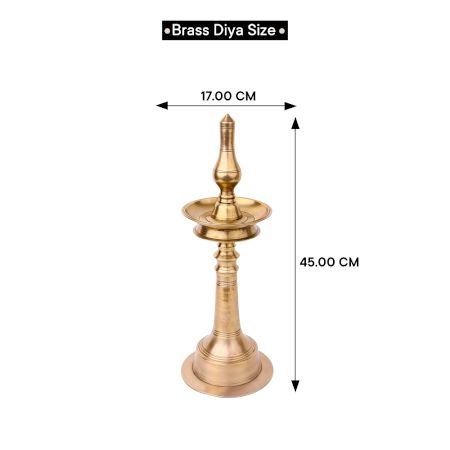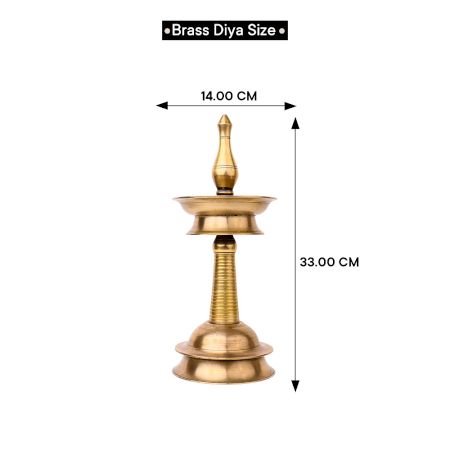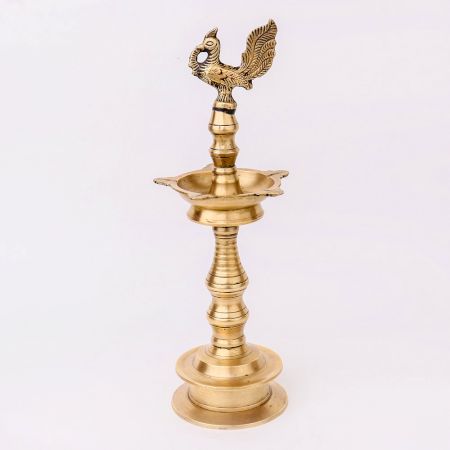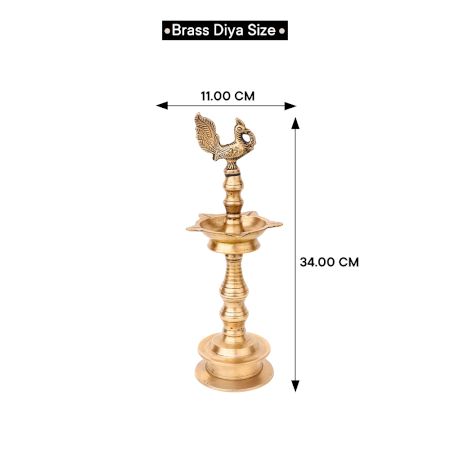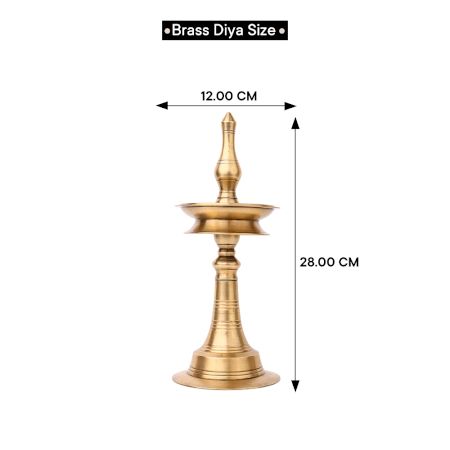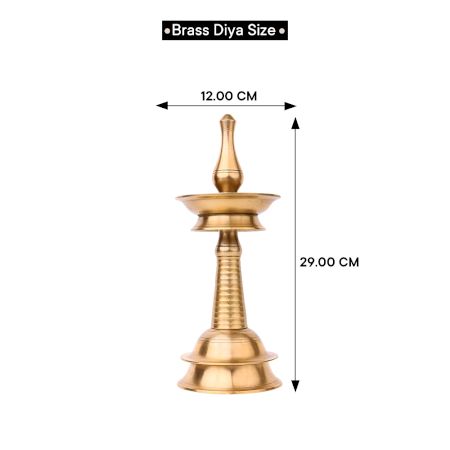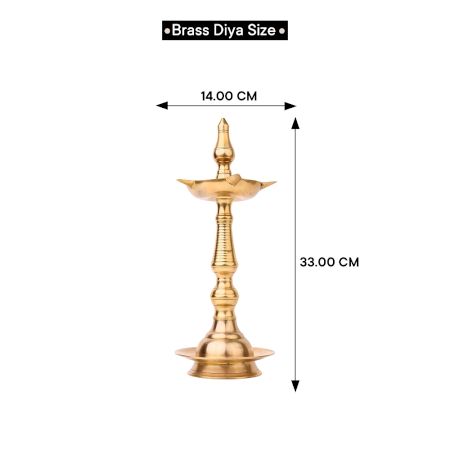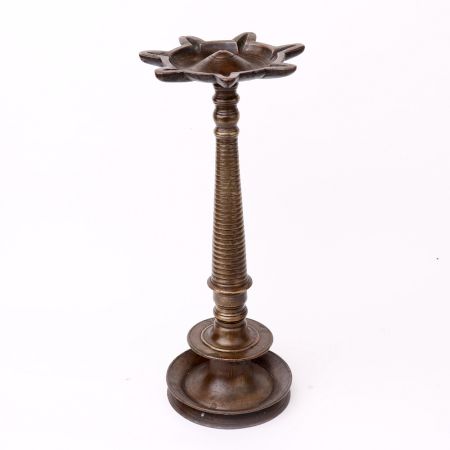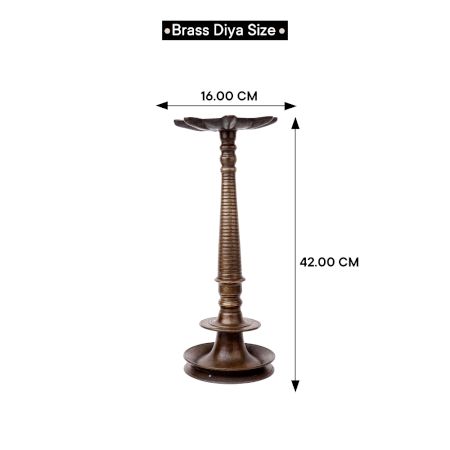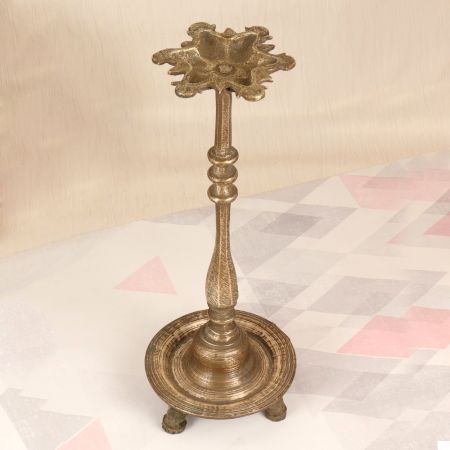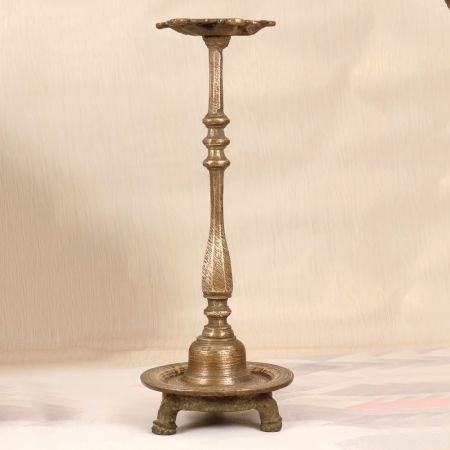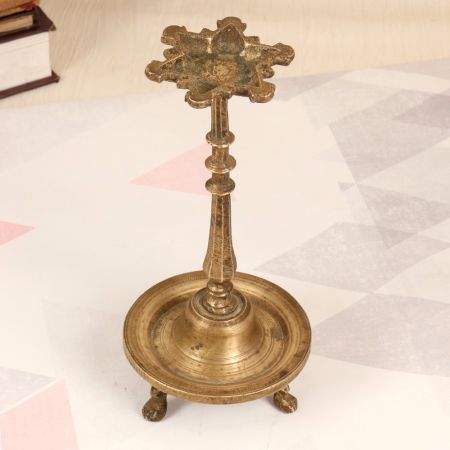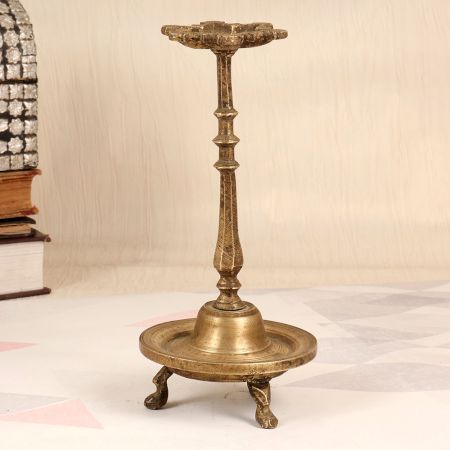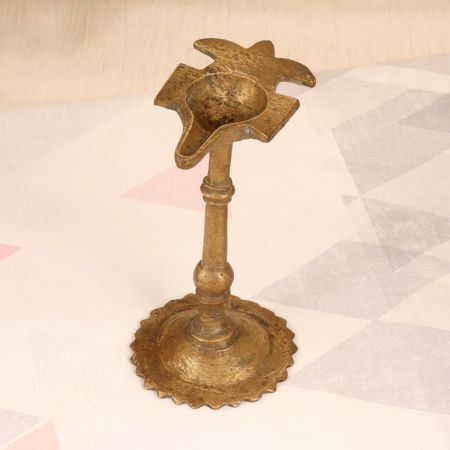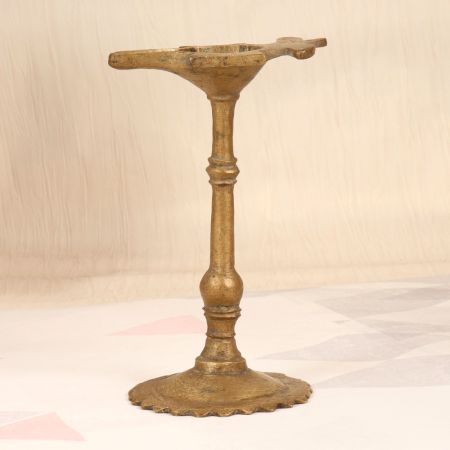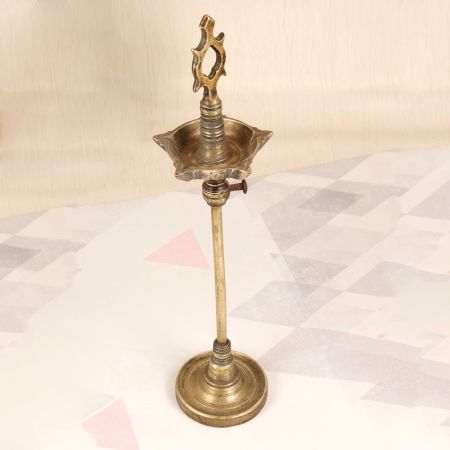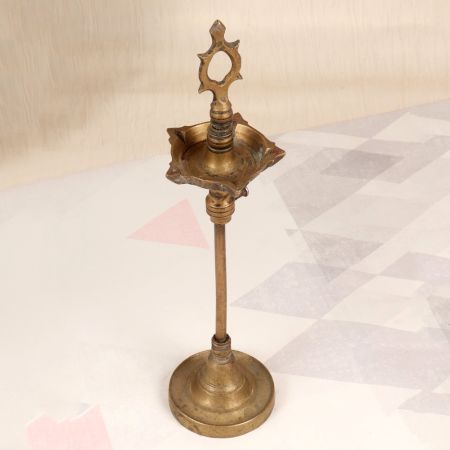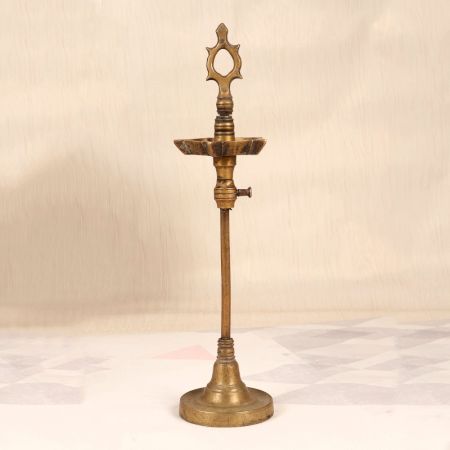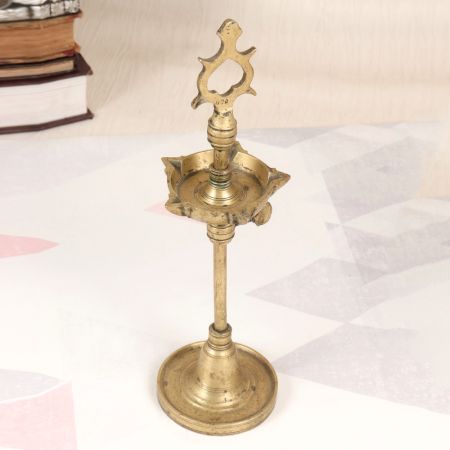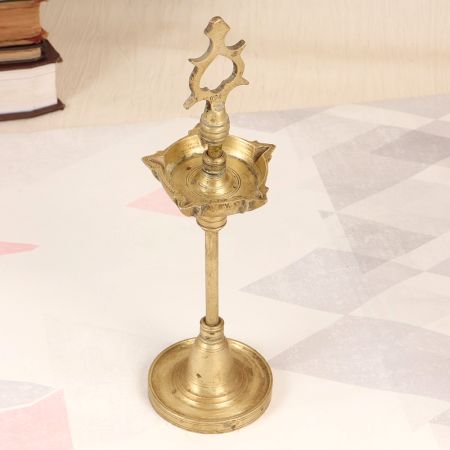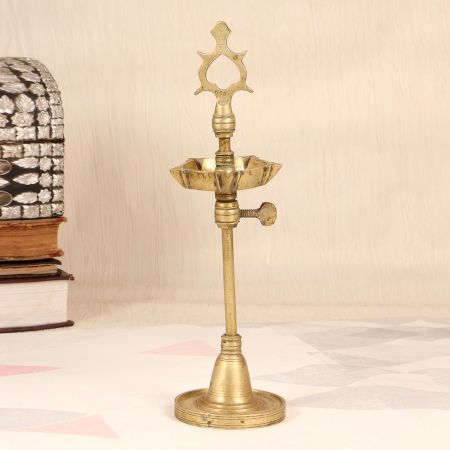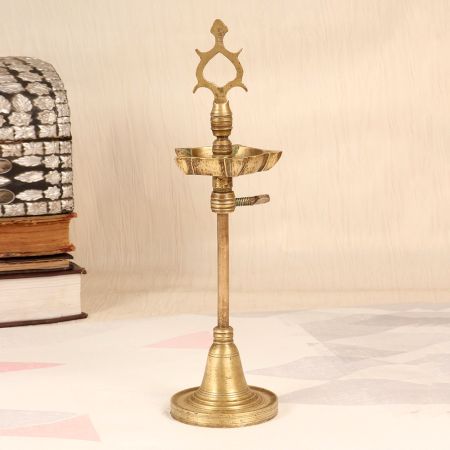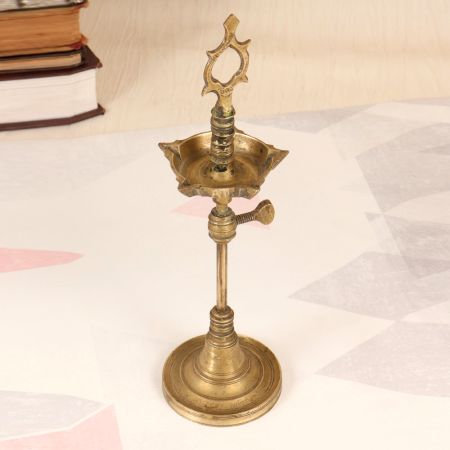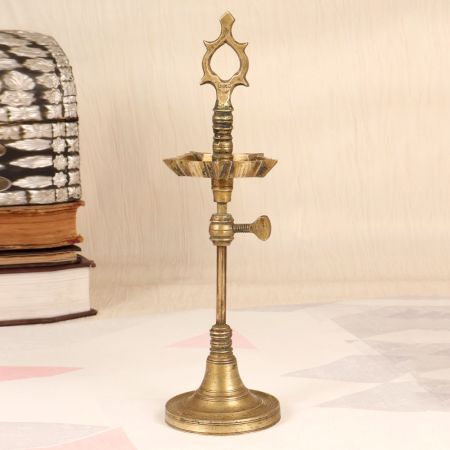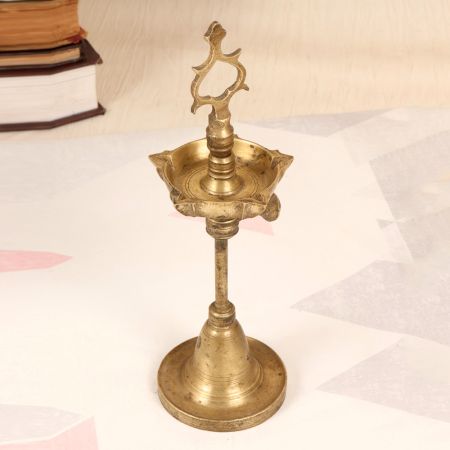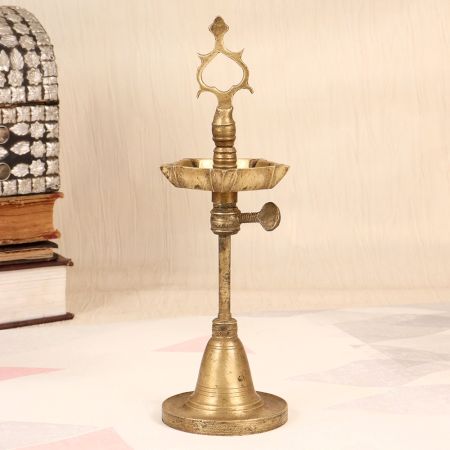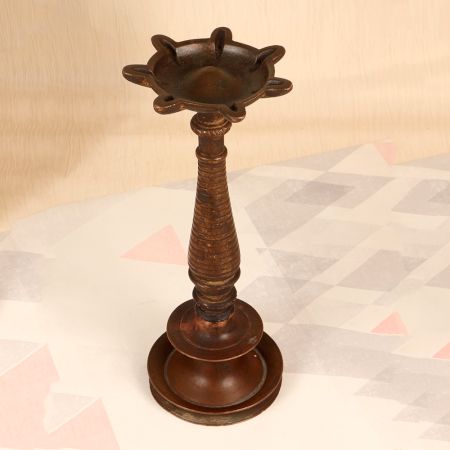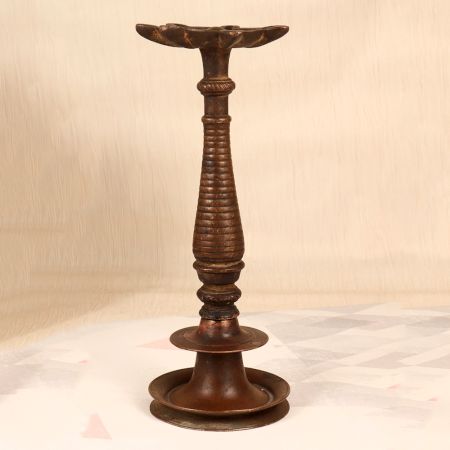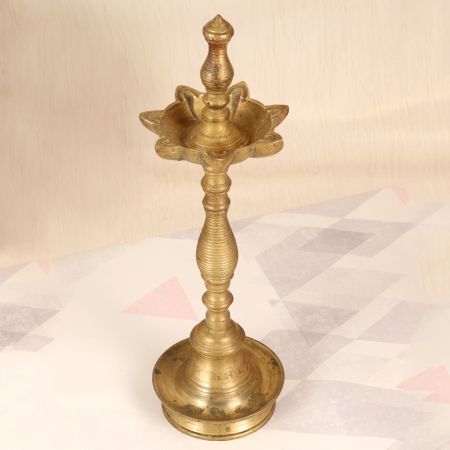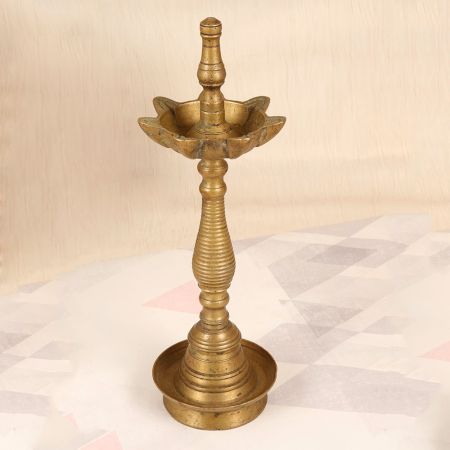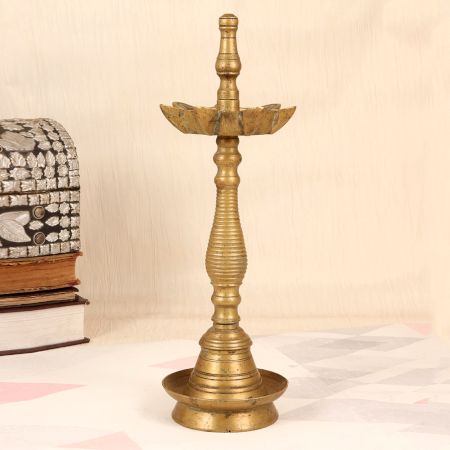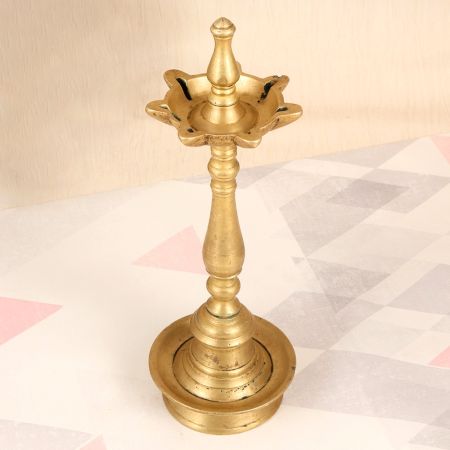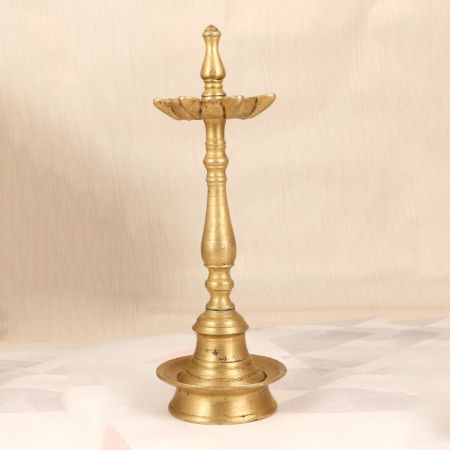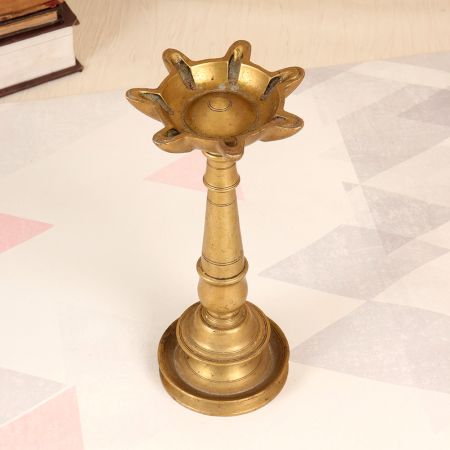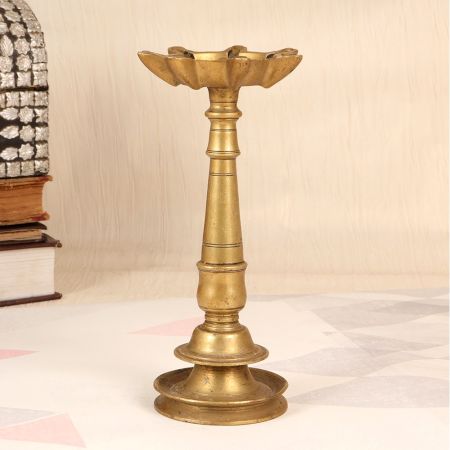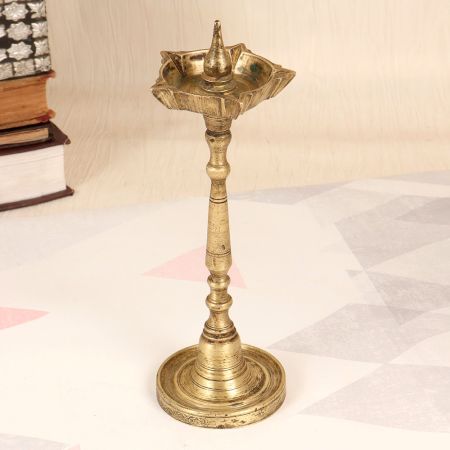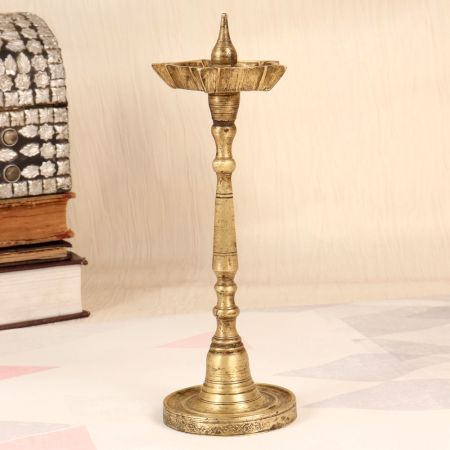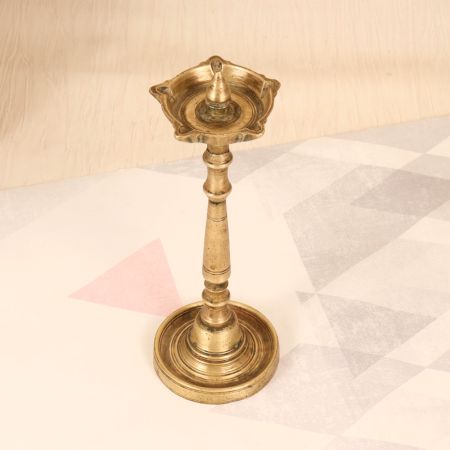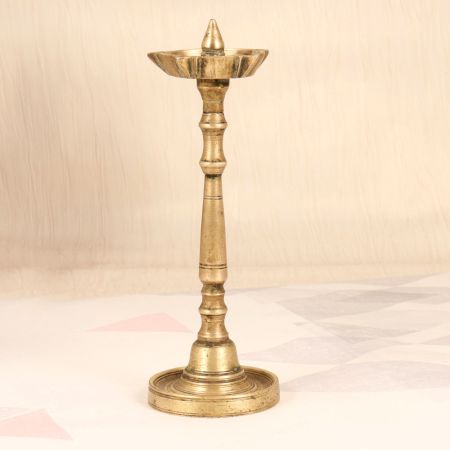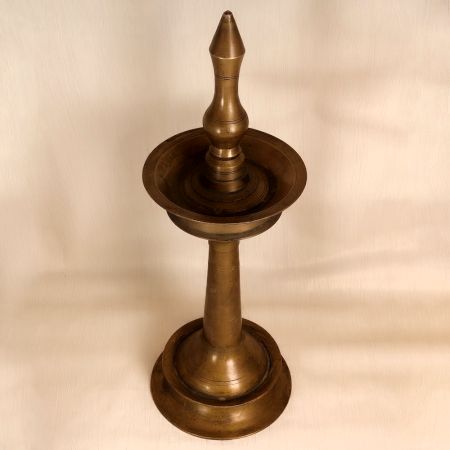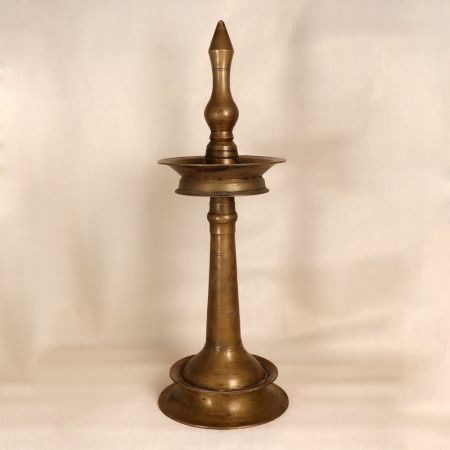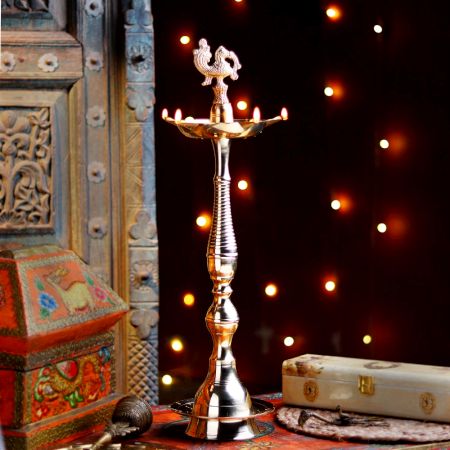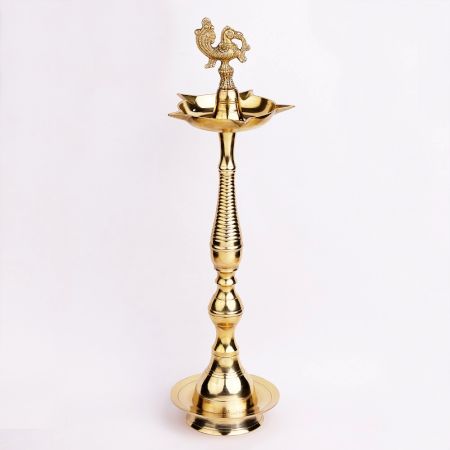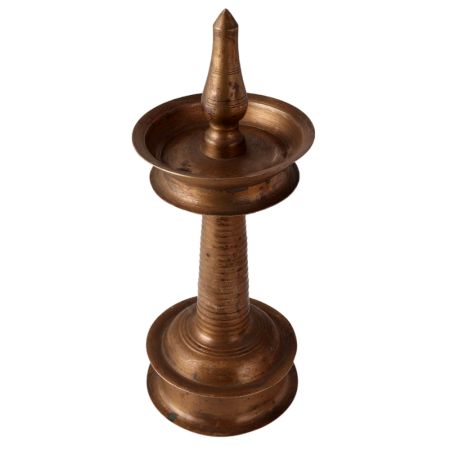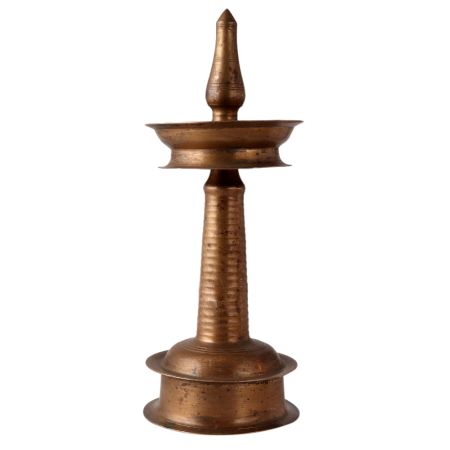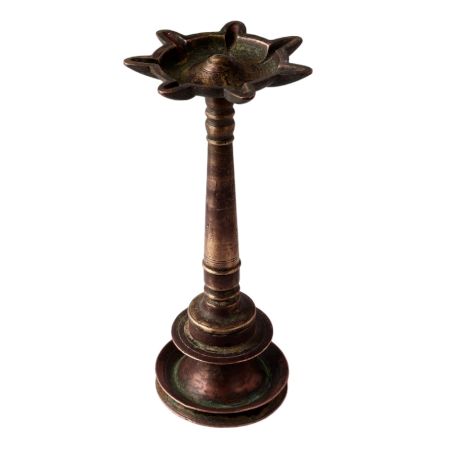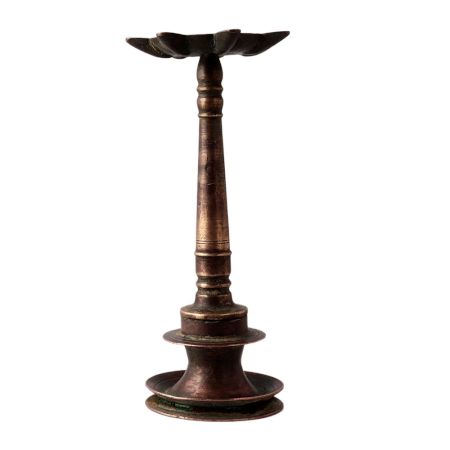-
South Indian Brass Oil Lamp Rituals Ceremonial Lamp With Stand
-
₹ 5,700.00
₹ 6,000.00 -
Only 1 left
-
₹ 5,700.00
General Understanding of Nilavilakku Lamps
The Nilavilakku is not merely an object of brass or bronze. It is a living presence in the quiet heart of Kerala’s homes and temples. Its flame does not just glow, it breathes, it waits, it remembers. In the stillness before prayers, its light marks the threshold between the worldly and the divine. The lamp is lit not only to brighten a room but to open a path for thought, devotion, and memory. Every turning of the wick is a turning of time itself, a silent conversation between the keeper and the unseen.
What Is A Nilavilakku Lamp?
A Nilavilakku lamp is a traditional standing oil lamp, deeply rooted in Kerala’s cultural and spiritual life. Unlike small diyas placed on the floor, it rises tall, often waist high, with a central stem, a wide circular base, and a bowl for oil and wick at the top. Its name blends two Malayalam words, ‘Nilam’ meaning floor and ‘Vilakku’ meaning lamp, suggesting its grounded yet elevated presence. It is usually lit with oil, often gingelly or coconut, and cotton wicks. In temples, festivals, and household rituals, its lighting signals the beginning of sacred acts. The lamp’s height, symmetry, and polished metal surface give it an almost human posture, as though it stands in witness. More than illumination, it holds cultural memory, it is the silent participant in generations of prayers, ceremonies, and moments of quiet reflection.
What Cultural Or Spiritual Emotions Do Nilavilakku Lamps Commonly Represent?
Nilavilakku lamps embody a union of stillness and vitality. Lighting one is not just a physical act, it is an emotional offering. It evokes reverence, purity, and the quiet anticipation that precedes prayer. The warm glow is often seen as the embodiment of knowledge, cutting through the darkness of ignorance. Families associate its flame with the blessing of ancestors and deities, believing that light invites auspiciousness into a space. In temples, it becomes a symbol of divine presence, its steady flame mirroring the steadfastness of faith. Even in homes, it acts as a gathering point, a place where eyes soften, voices lower, and thoughts rise above the ordinary. The emotion is layered, gratitude, humility, and a subtle joy that needs no loud declaration. It is a reminder that some of life’s most profound moments are lit not by chandeliers, but by a single steady flame.
What Are The Most Recognized Designs In Nilavilakku Lamps (E.g., Traditional Kerala Style, Temple Style, Ornamental Variants)?
The most recognized Nilavilakku designs are rooted in Kerala’s temple traditions. The Traditional Kerala Style is tall, simple, with clean lines and a balanced proportion between base, stem, and bowl, designed for both daily use and ceremonial dignity. The Temple Style is often larger, with broader bases and heavier metalwork, sometimes featuring sculptural details like mythical animals or floral motifs at the stem. Ornamental Variants can include intricate carvings, layered tiers of oil holders, or stylized pedestals, intended more for festive display or gifting. Some are small enough to be placed on an altar, others stand prominently at temple entrances. While proportions vary, each design maintains a deliberate symmetry, ensuring the flame is presented in a way that feels both grounded and exalted. These designs are not purely aesthetic, they embody function, symbolism, and centuries of artisan knowledge.
Why Are Nilavilakku Lamps Still Revered In Modern Homes And Ceremonies?
Nilavilakku lamps endure because they bridge heritage and living tradition. In modern homes, their presence is a conscious choice to keep a link with ancestral practices. Lighting the lamp each evening is an act that pauses the day, a ritual that refuses to be hurried. In ceremonies, from weddings to temple festivals, the Nilavilakku’s flame is an anchor of continuity. It represents a shared cultural rhythm, uniting generations in a single moment of illumination. Even in contemporary interiors, its golden gleam blends seamlessly with both traditional and minimal décor, proving that sacred symbols need no reinvention to remain relevant. More than nostalgia, it is the sense of rootedness it provides that keeps it alive. People still believe that the act of lighting the Nilavilakku does not just bring light into the room, it invites blessings into the heart.
Craftsmanship, Materials & Artistic Detailing in Nilavilakku Lamps
The making of a Nilavilakku is a ritual in itself. Each curve is measured not just in millimeters, but in centuries of repetition. The craftsman shapes the base for balance, the stem for elegance, and the bowl for steady light. Brass, bronze, and Panchaloha are chosen not just for their durability, but for the way they reflect firelight. Carvings, when present, are subtle, lotus petals, flowing vines, or temple bells, each catching the glow. In its final form, the Nilavilakku is not merely an object to hold oil, it is a keeper of silence, a witness to devotion, and a sculpted fragment of cultural memory.
How Were Traditional Nilavilakku Lamps Crafted?
Traditional Nilavilakku lamps were crafted by hereditary metal artisans who combined practical engineering with sacred geometry. First, raw metal, often brass or bronze, was melted and poured into moulds for the main sections, base, stem, and bowl. These sections were then individually shaped and polished using hand tools, ensuring precise balance so the lamp would stand steady on any surface. The proportions followed a time tested ratio, said to enhance both aesthetics and the steady burning of the flame. Surface finishing was done through meticulous polishing, giving it a mirror like glow that reflected the light. In some designs, artisans engraved motifs like the lotus, symbolizing purity, or the kalash, symbolizing abundance. The process was slow and deliberate, each stage infused with skill and reverence, making the lamp both a functional object and a sacred artefact meant to last for generations.
What Metals Or Alloys Were Commonly Used In Making Nilavilakku Lamps (E.g., Brass, Bronze, Panchaloha)?
The most common metals used in Nilavilakku crafting are brass and bronze, chosen for their durability, weight, and warm reflective surface. Brass, an alloy of copper and zinc, is especially popular because it retains polish well and resists corrosion. Bronze, an alloy of copper and tin, offers a deeper, antique tone, often preferred for temple settings. Panchaloha, a sacred alloy of five metals, gold, silver, copper, iron, and zinc, is rare but highly revered, believed to carry auspicious vibrations. The choice of metal affects not just appearance but the very aura of the flame. Brass gleams bright and warm, bronze radiates a deeper glow, Panchaloha carries a sense of sanctity. Each choice reflects not only aesthetic preference but also the intended use, daily home lighting, temple rituals, or ceremonial gifting.
What Role Do Size, Shape, And Carvings Play In The Aesthetic Of Nilavilakku Lamps?
Size, shape, and carvings are central to the lamp’s presence and personality. A tall, slender lamp conveys elegance and is ideal for temple entrances or central placement in a prayer hall, while a shorter, broader version feels intimate and suits a home altar. Shape affects balance, a wider base ensures stability, while a graceful stem enhances verticality. Carvings, whether floral, geometric, or symbolic, catch the light and add layers of meaning. A plain polished surface emphasizes purity, intricate detailing celebrates craftsmanship. The interplay of these elements determines how the lamp interacts with its surroundings, whether it stands as a quiet companion to prayer or as a grand ceremonial centerpiece. Each proportion is chosen with intent, ensuring the lamp feels neither ornamental excess nor functional minimalism, but a perfect union of both.
Symbolism, Rituals & Visual Significance of Nilavilakku Lamps
A Nilavilakku is not only lit, it is awakened. Its flame does not merely burn, it speaks in the language of shadows and gold. It tells stories of beginnings, of prayers whispered at dawn, of blessings sought at dusk. In its glow, rituals find their anchor, and spaces find their soul. The placement, the oil, the wick, all are part of a conversation between the seen and the unseen.
What Stories Or Spiritual Messages Do Nilavilakku Lamps Symbolize?
Nilavilakku lamps often symbolize the victory of light over darkness, knowledge over ignorance, and hope over despair. In many Kerala households, the first lighting of a Nilavilakku by a bride upon entering her new home represents the ushering in of prosperity and harmony. Temple festivals may feature multiple lamps lit in unison, symbolizing community unity and divine presence. Some folktales even describe the lamp as a witness to vows, capable of holding truth in its glow. Its steady flame becomes a metaphor for the steadfast human spirit, unwavering despite the winds. The lamp is not only a vessel for oil and wick, it is a vessel for stories, for the passing down of meaning from one generation to another, a visual sermon without words.
How Do These Lamps Reflect Religious, Cultural, Or Regional Traditions?
Nilavilakku lamps reflect Kerala’s deep intertwining of daily life with ritual. In Hindu temples, their lighting is an inseparable part of pujas, while in Christian homes in Kerala, similar standing lamps are lit during prayers, showing a cultural rather than purely religious devotion to the form. Regional festivals such as Vishu or Onam see the lamp at the heart of the décor, surrounded by flowers and offerings. Its design itself, with its tall stance and generous oil bowl, is uniquely adapted to the region’s aesthetics and spiritual philosophy. By being part of both domestic and public ceremonies, the Nilavilakku becomes a cultural bridge, crossing boundaries of faith while holding a distinctly Kerala identity. It tells of a land where light is not just utility but heritage.
How Do Flame, Light, And Placement Influence The Spiritual Ambience Of Nilavilakku Lamps?
The flame is the lamp’s soul, its height, steadiness, and warmth determine the emotional tone of a space. A high, steady flame creates an aura of reverence, perfect for temples or ceremonial stages. In a home, a softer flame invites intimacy and calm. The quality of light, golden, flickering, or bright, depends on the oil and wick, and can shift a mood from meditative to celebratory. Placement is equally vital, at thresholds, it welcomes, at the altar, it sanctifies, in the courtyard, it connects the sky to the earth. The combination of flame, light, and placement transforms the Nilavilakku from an object into an atmosphere, a living, breathing participant in the space it inhabits.
Purchase, Collection & Investment in Nilavilakku Lamps
To hold a Nilavilakku is to hold a fragment of South Indian heritage in your hands. The purchase is never just a transaction. It is a moment where you decide to invite a tradition into your space, to let brass and flame narrate their timeless story. A collector sees beyond utility, sensing the history in the weight of the metal, the patina that whispers of many dawns and dusks. As an investment, it becomes more than material. It is an heirloom in waiting, a cultural bookmark passed from hand to hand, across years, across lives.
Where Can You Buy Authentic or Antique Nilavilakku Lamps?
Authentic Nilavilakku lamps are best sourced from trusted antique dealers, heritage craft fairs, and artisanal markets across Kerala and Tamil Nadu. Some temple towns still have traditional brass smiths who create these lamps using age old techniques, each piece bearing subtle variations that speak of handwork. When purchasing online, it is vital to choose verified sellers like IndianShelf who can provide provenance or certification. Markets in Kochi, Thiruvananthapuram, and Madurai are known for their authenticity. Auctions sometimes present rare finds, but prices reflect the scarcity. In each case, the buying experience is not just about possession but about respect, walking into a space with the intent to preserve a piece of cultural soul. An authentic lamp is rarely shiny and new, it often carries a mature glow, speaking more through its quiet dignity than through polish.
How Can You Verify the Authenticity of a Nilavilakku Lamp?
Authenticity lies in details you cannot rush to notice. Examine the weight, older lamps are heavier because they are made from pure brass or bronze alloys. Look at the symmetry, handcrafted lamps carry slight irregularities that machine production cannot mimic. Patina is another tell, genuine antique lamps develop a deep, even toned surface aging that feels organic, not artificially applied. Ask for documentation if available, especially for high value purchases. Traditional motifs like the peacock, lotus, or simple stepped stems often have carving depth that modern replicas lack. If you have access to an expert or appraiser, their trained eye can reveal inconsistencies quickly. In the end, authenticity also carries an emotional recognition, a certain warmth when you touch it, as if the lamp has lit many evenings before yours.
What Makes a Nilavilakku Lamp a Worthwhile Cultural or Artistic Investment?
A Nilavilakku is both a cultural witness and a work of enduring artistry. It has survived centuries because it embodies more than function, it is ritual, symbolism, and design in one. As an investment, its worth increases with its craftsmanship, historical relevance, and preserved condition. Antique pieces, especially those linked to specific temples or ceremonies, often appreciate in value. But even beyond financial gain, there is the emotional dividend, a sense of being a custodian of heritage. Each lamp bridges the past and present, and in keeping it, you participate in the chain of cultural preservation. Unlike transient décor trends, a Nilavilakku retains meaning across time, ensuring that your investment is not only measured in currency but in legacy.
Care, Polishing & Preservation of Nilavilakku Lamps
Preservation is not about making old things look new. It is about allowing age to wear with grace. A Nilavilakku lamp breathes through its brass, and its shine is a living thing, fading and returning through touch and time. Caring for it requires patience, gentle hands, and the right oils that feed the metal rather than strip it. Storage away from harsh moisture and chemicals is as important as polishing. Restoration, when needed, must honor the original form and texture. Above all, care is an act of gratitude, a small offering to an object that gives light.
How Do You Properly Clean and Maintain a Nilavilakku Lamp?
Cleaning a Nilavilakku is a slow ritual. Begin with removing any wax or oil residue using warm water and mild soap. Avoid abrasive scrubbing, as it can scratch the surface and erase delicate detailing. Dry the lamp thoroughly to prevent water spots or corrosion. For regular maintenance, a soft cloth can be used to wipe away dust. If the lamp is used for oil lighting, make sure to clean the wicks and oil cup after every use to prevent buildup. Store the lamp in a dry space, preferably wrapped in a soft cotton cloth to avoid contact with moisture. Overcleaning can strip away the natural patina that adds depth and authenticity to the lamp’s look. By treating the process as a careful conversation with the object, you help it age with beauty and remain strong for decades.
What Polishing Methods and Oils Best Preserve the Shine and Finish?
For polishing, natural methods are always gentler and more respectful of the lamp’s metal. A paste of lemon juice and fine salt or tamarind pulp can restore shine without harming the surface. Rinse thoroughly and dry immediately. Brass or bronze specific oils, like coconut oil or til (sesame) oil, can be lightly applied with a soft cloth to keep the surface nourished and prevent tarnish. Avoid harsh chemical polishes that create an unnatural brightness and weaken the metal over time. When polishing, work in circular motions, following the flow of the design rather than forcing the shine. The goal is not to make the lamp look freshly manufactured, but to allow it to glow with the maturity of its years. The right oiling not only protects but deepens the character of the brass.
Can Damaged Nilavilakku Lamps Be Restored Without Losing Their Original Charm?
Yes, but restoration must be approached with sensitivity. Small dents, loose joints, or worn motifs can often be repaired by experienced brass craftsmen without compromising authenticity. Traditional metalworking workshops in Kerala and Tamil Nadu still practice methods where the repair blends seamlessly with the existing structure. Avoid overly aggressive sanding or machine buffing, as these can erase historical marks and detailing. If structural damage exists, such as a broken stem or cracked base, a skilled restorer can reforge the part while retaining its visual continuity. The most successful restorations do not aim to make the lamp look untouched, but to preserve its ability to stand, to shine, and to tell its story with all its honest scars intact.
What Are Common Signs of Wear or Corrosion in Old Nilavilakku Lamps?
Common signs include greenish oxidation spots (verdigris), pitting on the metal surface, or uneven dark patches that suggest tarnish. Loose or wobbly parts can indicate weakened joints. Over time, excessive moisture can cause fine hairline cracks in the base or stem. If the lamp has been polished too often with abrasive methods, you may notice flattened details or dulled motifs. In some antique lamps, the wick holders may appear misshapen from years of heat exposure. Recognizing these signs early allows you to take preventive measures, gentle cleaning, oiling, or professional repair, before the damage becomes irreversible. Each mark tells a chapter of the lamp’s life, but unchecked corrosion can close that book too soon.
Home Decor, Rituals & Mood Setting With Nilavilakku Lamps
A Nilavilakku is not just a source of light, it is an anchor for mood and meaning. When lit, it spills a soft, golden radiance that transforms spaces from ordinary to sacred. It can stand in the quiet of a corner or in the grand welcome of a hallway, adapting to both personal devotion and festive splendor. In décor, it blends the old with the modern, lending warmth to marble, wood, or stone. In rituals, it becomes a vessel of prayer. Its presence in any setting is both aesthetic and deeply emotional, light made tangible.
How Can Nilavilakku Lamps Influence a Home’s Spiritual or Festive Atmosphere?
The warm, steady glow of a Nilavilakku instantly shifts the energy of a room. Spiritually, it is believed to invite positivity, clarity, and peace into the home. The flame becomes a meditative focus, calming the mind while anchoring rituals. During festivals, especially Onam, Vishu, or Diwali, the lamp’s light expands the sense of celebration, making every corner feel alive with tradition. The act of lighting it daily can become a grounding practice, marking the transition from day to night with grace. Even in a purely decorative role, the lamp’s presence suggests reverence, heritage, and continuity, elements that subtly influence the way people experience a space. It does not just brighten a room, it alters its emotional temperature.
What Interior or Temple Styles Pair Well with Nilavilakku Lamps?
Nilavilakku lamps pair beautifully with traditional Kerala and Tamil Nadu interiors, where wooden ceilings, carved pillars, and open courtyards create a natural stage for their glow. In temple settings, they complement Dravidian architecture, granite floors, and stone idols, creating an unbroken visual harmony. In modern homes, they can serve as accent pieces in minimal spaces, their ornate form contrasting gently with clean lines and neutral palettes. A brass lamp placed beside indoor plants, terracotta décor, or temple style niches instantly evokes a feeling of rootedness. Whether surrounded by murals, silk drapes, or bare white walls, the lamp adapts, bridging time periods and design languages without losing its own identity.
How Do You Choose the Right Nilavilakku Lamp for a Pooja Room, Hallway, or Festive Setting?
Choosing the right lamp begins with the space it will inhabit. For a pooja room, smaller or medium sized lamps with simple stems suit intimate rituals. In hallways or large living rooms, taller, multi tiered lamps create an impressive focal point. For festive settings, ornate designs with peacock or lotus motifs enhance visual richness. Consider the base width for stability, especially if placed in areas with foot traffic. The material finish matters too, antique brass gives warmth, while polished brass offers brightness. Practicality and symbolism should guide your choice. The lamp should feel proportionate to the room and purpose, blending effortlessly into the atmosphere while commanding silent attention.
Cultural Impact & Historical Legacy of Nilavilakku Lamps
The Nilavilakku is not merely an object of light but a vessel of continuity, holding centuries of belief within its bronze body. In temples, homes, and festivals, its flame becomes the breath of ritual, an unbroken gesture that binds generations. The act of lighting it is not an act of illumination alone, it is an invocation, a quiet summoning of prosperity, clarity, and harmony. Its presence in South Indian culture is a testament to how art, utility, and devotion merge seamlessly. Even today, the Nilavilakku’s glow outlasts the passing hours, whispering stories older than stone.
What Is the Historical Significance of Nilavilakku Lamps in South Indian Traditions?
The Nilavilakku is rooted in centuries of temple worship and household rituals across Kerala and Tamil Nadu. Historically, it served as the sacred threshold between the material and spiritual realms. In temples, it marked the start of daily pujas, in homes, it stood as the first light of dawn and the last to fade at night. More than a functional source of light, it symbolized purity, its steady flame seen as a divine witness to prayers, vows, and celebrations. In agrarian societies, it also marked seasonal transitions, lit during harvest festivals and marriages to bless abundance. The Nilavilakku’s endurance lies in its adaptability, it has remained relevant through dynasties, colonial transitions, and modernity without losing its symbolic weight. Even today, in an era of electric brilliance, many still seek its oil-fed glow as an anchor to heritage. Its history is not written in books alone but in the daily repetition of its lighting.
How Did Different Regions of Kerala and Tamil Nadu Contribute to the Evolution of Nilavilakku Designs?
Kerala and Tamil Nadu shaped Nilavilakku designs in ways that reflect their cultural and architectural landscapes. In Kerala, the lamps often feature a tall, slender stem with a deep, lotus-like basin, echoing the state’s wooden temple architecture and emphasis on vertical grace. Tamil Nadu’s variations, by contrast, lean toward heavier bases, ornate motifs, and sculptural details drawn from Dravidian temple carvings. Some designs borrow iconography from regional deities, while others remain purely floral or geometric. Coastal trade introduced influences from Sri Lanka and Southeast Asia, subtly altering proportions and ornamentation. Over centuries, these regional dialogues created a vast design vocabulary, from towering ceremonial lamps used in temple festivals to compact, understated forms for domestic altars. This evolution was not merely aesthetic, it reflected the adaptability of artisans to local rituals, climatic conditions, and patron demands, ensuring the Nilavilakku remained a living tradition rather than a static relic.
Which Artisans and Communities Have Preserved the Craft of Nilavilakku Making Over Generations?
The legacy of Nilavilakku making rests with hereditary artisans, many belonging to traditional metalworking communities like the Moosari in Kerala and the Vishwakarma in Tamil Nadu. For these craftsmen, creating a lamp is not mere fabrication, it is a sacred act governed by proportions, symbolism, and ritual purity. Skills pass from parent to child, not only through hands-on apprenticeship but through oral tradition, where each curve, joint, and polish carries meaning. Some families trace their lineage of lamp-making back centuries, with temple records noting their contributions. In modern times, artisan cooperatives and cultural preservation initiatives have helped sustain the craft against industrial competition. Yet, it is the deep emotional commitment of these communities, treating each lamp as both art and offering, that ensures the Nilavilakku retains its authenticity. Their persistence has kept the lamp from being reduced to mere décor, preserving its role as a sacred heirloom across generations.
Nilavilakku Lamps vs Other Traditional Lamps
The Nilavilakku’s elegance lies in its upright stance, its flame rising like a prayer unbroken. Unlike other lamps that often lean toward ornamentation first, this lamp’s form follows function, steady, balanced, and capable of holding light for hours without wavering. Its vertical grace and deep oil basin set it apart from the broader Indian oil lamp tradition. Where others may be rooted in specific deity worship, the Nilavilakku bridges both domestic and temple spaces. It is a lamp of thresholds, between dusk and dawn, sacred and familiar, making it both humble and majestic, adaptable yet unmistakably rooted in South Indian soil.
How Are Nilavilakku Lamps Different from Other Indian Oil Lamps like Kamatchi Vilakku or Mayur Vilakku?
Kamatchi Vilakku lamps are closely tied to the goddess Kamakshi, often featuring her form in the central pillar, making them deeply specific to Shakti worship. Mayur Vilakku, on the other hand, incorporates peacock motifs, symbolizing beauty, knowledge, and the arts. Both are visually ornate and often smaller in height compared to ceremonial Nilavilakku variants. The Nilavilakku differs in its simplicity of form, focusing on balance, endurance, and uninterrupted flame rather than symbolic imagery. It is designed to stand tall, sometimes above waist height, making it more suitable for continuous temple rituals. Its deep basin can hold more oil, ensuring longer burn times, while the wide base keeps it stable even in large gatherings. This makes it a universal ritual lamp in South Indian traditions, transcending the specific deity associations of Kamatchi or Mayur lamps. Its strength lies in being both a vessel of light and a vessel of continuity.
What Sets Nilavilakku Lamps Apart from Modern Decorative Lamps?
Modern decorative lamps may dazzle with glass shades, electric fittings, and quick adaptability, but they often lack the ritual gravitas of a Nilavilakku. The Nilavilakku is not designed for quick switching on, it demands a deliberate act of preparation, cleaning, filling with oil, placing the wick, and lighting with intention. This process itself becomes meditative, binding the act of illumination to mindfulness. In contrast, modern lamps serve primarily as ambient décor or functional lighting, detached from tradition. The Nilavilakku, even when placed in a contemporary setting, carries with it the weight of centuries. Its glow is softer, more organic, casting shadows that seem to move with memory. It is not about convenience, it is about presence. That is why, even in sleek apartments, a Nilavilakku can command the same quiet respect it does in a centuries-old temple corridor.
How Do Tall Nilavilakku Variants Differ from Table-Top or Ornamental Designs?
Tall Nilavilakku lamps are ceremonial by nature, often standing as high as a person’s chest or more. They are designed for visibility in large temple halls and public rituals, where their flames need to be seen from a distance. Their proportions are carefully calculated for stability, with wide bases and weight distribution that prevent tipping. Table-top or ornamental variants, by contrast, are compact, often crafted for domestic pujas or decorative use. These smaller versions may feature more intricate carvings or lighter metal to suit easy handling. While tall versions emphasize endurance and public visibility, table-top designs prioritize intimacy and accessibility. Both share the same symbolic essence, but their forms reflect their context, one towering as a beacon in collective worship, the other quietly holding light within the rhythms of daily life.
Emotional & Symbolic Value of Nilavilakku Lamps
A Nilavilakku is more than bronze and oil, it is memory cast into metal. Every time the wick catches fire, it summons moments from countless ceremonies past. It stands in wedding halls as a silent blessing, in temple corners as a steadfast witness, and in homes as the quiet heart of evening prayers. Its flame does not simply light a room, it lights a feeling, a continuity of faith and affection. Passed down through generations, it gathers the fingerprints of those who have cared for it. In its glow, the past and present sit together without speaking.
Can Nilavilakku Lamps Be Meaningful Gifts for Weddings or Housewarmings?
Yes, a Nilavilakku can be one of the most meaningful gifts for weddings and housewarmings because it carries a deep cultural and emotional charge. In weddings, it symbolizes the light of new beginnings, a shared life illuminated with prosperity and harmony. In housewarmings, it acts as a guardian, bringing blessings into a new space and anchoring it in tradition. Unlike purely decorative items, a Nilavilakku requires interaction, it must be lit, cleaned, and cared for. This makes it an ongoing reminder of the giver’s blessing rather than a forgotten ornament on a shelf. In many South Indian households, gifted Nilavilakkus are preserved for decades, sometimes even becoming the family’s main ceremonial lamp. Each lighting renews the original intention of the gift. It is not simply a present, it is a lasting presence, one that travels with the family’s story through the years.
What Emotional Value Do Heirloom Nilavilakku Lamps Hold in Families?
An heirloom Nilavilakku often carries more emotional value than almost any other household item. It is not just a possession but a living connection to ancestors. Every dent, every polish mark, tells of the hands that held it before. When lit, it feels as though those who are gone still stand in the room, watching the flame with quiet pride. Families bring out these lamps on important occasions, giving them a place of honor as if they were guests. The act of lighting such a lamp can be deeply moving, a reminder of weddings, festivals, and milestones it has witnessed. In some cases, it has been present at multiple generations of the same ceremony. This continuity creates a thread between the past and the present, allowing families to feel that they are not just keeping a lamp but keeping a promise.
Why Do People Feel a Deep Connection to Lighting Nilavilakku Lamps During Rituals?
The connection comes from the layered meanings built into the act itself. Lighting a Nilavilakku is slow and deliberate, and this unhurried process allows the mind to shift from daily noise to ritual focus. The flame becomes more than light, it becomes a symbol of clarity, protection, and divine presence. In many traditions, the lamp is lit facing east, welcoming the energy of the rising sun into the space. The soft flicker of the oil-fed wick creates a meditative rhythm, drawing the observer into stillness. For many, this moment becomes personal, a quiet conversation with the divine or with their own inner self. The lamp’s warm glow also changes the atmosphere of the room, making even the simplest space feel sacred. This emotional connection is why, despite modern lighting, the Nilavilakku remains irreplaceable in South Indian rituals.
Frequently Asked Questions (FAQs)
What Defines a Lamp as a Nilavilakku?
A Nilavilakku is defined by its tall, upright structure, deep oil reservoir, and traditional South Indian design proportions. It is typically crafted from brass or bronze and built to hold multiple wicks. The base is wide and stable, the stem slender yet sturdy, and the oil cup often shaped like a lotus. It is intended for steady, prolonged burning, making it ideal for temple or domestic rituals. Unlike purely decorative lamps, a Nilavilakku follows cultural guidelines for size and shape, ensuring both symbolic and functional integrity.
Can Traditional Nilavilakku Designs Be Recreated Authentically Today?
Yes, traditional Nilavilakku designs can be recreated authentically today as long as skilled artisans follow the established proportions, materials, and methods. Many hereditary metalworkers continue to use techniques passed down for generations, including hand-casting and detailed hand-finishing. Some modern reproductions even involve temple priests advising on proper measurements and symbolism. The key is not just physical accuracy but cultural authenticity, ensuring the lamp is more than an imitation and instead a continuation of the tradition.
How Do You Protect Nilavilakku Lamps from Tarnish and Weather Damage?
Nilavilakku lamps can be protected from tarnish by regular cleaning with a mild brass polish or natural agents like tamarind paste or lemon juice. They should be dried completely after washing to prevent moisture stains. For lamps kept outdoors or in humid areas, applying a thin layer of oil after cleaning can slow oxidation. Avoid abrasive scrubbing, which can scratch the surface and reduce shine. When stored, wrap the lamp in soft cloth to protect it from dust and temperature changes.
Are Nilavilakku Lamps Still Relevant in Modern Homes and Temples?
Yes, they remain deeply relevant. In homes, they anchor daily prayer rituals and seasonal festivals, providing a connection to cultural roots. In temples, they are essential for ceremonial lighting, often used in processions and evening prayers. Their presence is both functional and symbolic, bridging past traditions with present-day practice. Even in urban apartments, smaller variants find a place in prayer corners, proving that relevance is a matter of meaning rather than scale.
Can Nilavilakku Craftsmanship Be Adapted to Contemporary Decor Styles?
Yes, many modern designers collaborate with traditional artisans to create Nilavilakku-inspired pieces that fit into contemporary interiors. These may involve slight changes in size, finish, or decorative motifs while keeping the essential form intact. Matte-finish brass, minimal carvings, or mixed-material bases can make them blend into modern spaces without losing cultural identity. This adaptation allows the Nilavilakku to remain part of daily life while appealing to changing aesthetic preferences.
